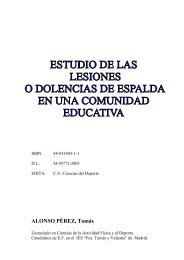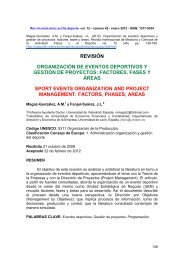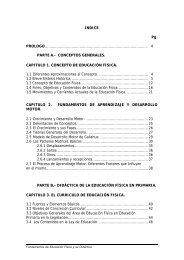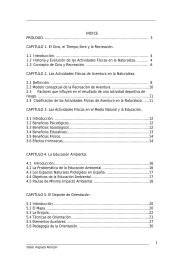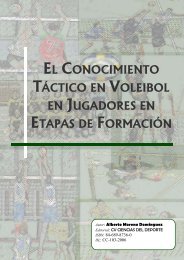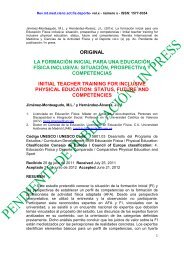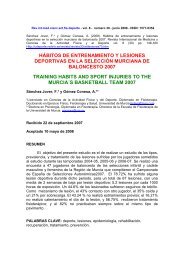Manual de Teoría y Práctica del Acondicionamiento Físico
Manual de Teoría y Práctica del Acondicionamiento Físico
Manual de Teoría y Práctica del Acondicionamiento Físico
Create successful ePaper yourself
Turn your PDF publications into a flip-book with our unique Google optimized e-Paper software.
2. 2. Métodos <strong>de</strong> entrenamiento<br />
Consi<strong>de</strong>raciones Previas<br />
“Los ejercicios <strong>de</strong> flexibilidad tendrán siempre un carácter generalizado, será<br />
imprescindible realizarlos durante y al término <strong>de</strong> las activida<strong>de</strong>s <strong>de</strong> resistencia y fuerza, para<br />
proporcionar la justa longitud <strong>de</strong> aquellos haces musculares que han sido contraídos intensa y<br />
repetidamente” (Fucci y Benigni 1988).<br />
“Todas las articulaciones <strong>de</strong>ben ser afectadas. El calentamiento pue<strong>de</strong> ser el momento<br />
diario que utilicemos para estos ejercicios. En la fase final <strong>de</strong>l mismo y antes <strong>de</strong>l inicio <strong>de</strong>l<br />
entrenamiento propiamente dicho y también al final <strong>de</strong> éste” (J. Bravo 1985).<br />
También <strong>de</strong>beríamos tener en cuenta el concepto <strong>de</strong> búsqueda <strong>de</strong>l equilibrio muscular<br />
(Spring et al, 1992).<br />
CONTRACCIÓN<br />
(Músculos tónicos)<br />
Falta y exceso <strong>de</strong> carga<br />
Gimnasia errónea<br />
Lesión<br />
Este <strong>de</strong>sequilibrio muscular se <strong>de</strong>bería compensar <strong>de</strong> la siguiente manera:<br />
Extensibilidad<br />
CONTRACCIÓN<br />
DESEQUILIBRIO<br />
MUSCULAR<br />
DESEQUILIBRIO<br />
MUSCULAR<br />
Lesión<br />
Inactividad<br />
DEBILITAMIENT<br />
O<br />
DEBILITAMIENT<br />
O<br />
Fortalecimiento<br />
137



